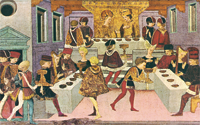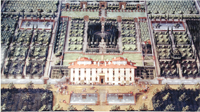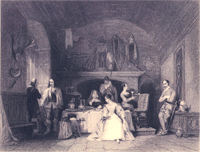
Feudalism in decline
1.200 A.D. FEUDALISM IN DECLINE
THE END OF THE MIDDLE AGESThe end of the Middle Ages ws marked by various economic and social factors. Population growth was imposing more and more demand for food, but trade remained precarious. The land, in turn, demonstrated productive insufficiency, as planting techniques were far too primitive, besides always being subject to the risks of pests and droughts. Thus, the XIII and XIV centuries were marked by major food shortages, high prices and devastating epidemics, like the Black Plague, which, in Europe, decimated 1/3 of the population.
In order to flee from the Black Plague, many serfs abandoned their feudal situations, causing generalized disorganization in production in the countryside. One part of this contingent headed towards the cities and another roamed the the woods, turned into outlaws. This shift results in reductions of agricultural surpluses and serious commercial losses. As a result, for years, great food shortages hit Europe as a whole.

OLIVE OIL FORGOTTEN
In 1891, Pellegrino Artusi, literato and humanist, wrote the book, ?La Scienza in Cucina e l?Arte di Mangiar Bene - Manuale Prático Per Le Famiglie?, in which he describes a banquet put on by Galeazzo II and Bianca di Savoia to celebrate the wedding of his daughter, Violante with Lionello, Duke of Clarence, son of the King of England, in Milan, on 15th June 1368. To give an idea of the magnificence of this banquet, suffice to say there were 18 different menus. Among the dishes served, there were capao chicken, chicken, quail, partridge, duck, falcon, peacock, swan, hare, beef, tongue, veal, piglet, goat, venison, trout, carp, eel, lamprey, and pastas,.A curious fact for olive oil fans is that, in the whole description of the banquet, where the dishes of each menu are described, there is not one mention of olive oil. In this period at the end of the Middle Ages, although the feudal landlords maintained possession of the land, they were losing their main productive input, the serf. Thus, there began, albeit embryonic, a new mode of production with the landlords resorting to paying salaries to their workers. In some regions of Europe, at the beginning of the XV century, slave traffic re-emerged to fill the labour gap. This explains, in part, the continuation of the Andalusian predominance in the production of olive oil, when dozens of thousands of negroes were imported to work on the local plantations (Liberdade e Servidão - Pierre Bonnassie). Although this fact goes almost unnoticed throughout history (according to Alessandro Stella, there was a veritable genocide, eliminating any vestige of the existence of this slave labour), it is certain that this enormous contingent of slave labour was significant in the resumption of the olive oil trade.

A REVOLUTION IN THE COUNTRYSIDE
The asymmetric plough with wheels, just a moldboard and ploughshare, a new system of harnessing to horses and oxen: the invention of the 4-wheeled cart, water control, and from this, grain and olive oil mills, plus the perfection of tool manufacture, suggest improvements in the agricultural techniques of the Middle Ages (Dicionário Temático do Ocidente Medieval - diversos). However, one cannot generalize about anything in that period. Every country, every region, every space of 10 years created unpredictable climatic, social, political and cultural alterations, with diverse results. We can only affirm that wheat, rye, oats, vetch, peas and lentils are foods that, due to the rapidity and simplicity of production, provided the basic nutritional needs of the people.Little by little, the peasants broke free from the restraints that had kept them under a mediaeval semi-slavery regime. Those serfs skilled in crafts sought the cities to sell their productive capacity in more human, more profitable conditions. The feudal lord found himself obliged to find incentives for production in their domains. With this, the peasant began to accept payment in cash instead of a significant part of the harvest. He became aware that producing more meant having more to sell and earn more. On the other hand, those landlords who did not submit to the new reality, saw their serfs flee from the oppression that had stagnated them. They migrated to distant regions in search of better conditions for production. Besides these contributory factors, the growth in agricultural production was possible through an increase in productivity of the land and also due to the occupation of immense tracts that had hitherto been unproductive. According to Leo Huberman in his História da Riqueza do Homem, in the XII century, Only half of the land in France, a third in Germany and one fifth in England were cultivated. Marshes, virgin forest or unusable land began to be occupied. All the complex set of changes in the feudal landlord and serf relation determined the growth of trade, the introduction of money into the economy and the expansion of the cities. There was an ever growing demand for agricultural production. The combination of these structural factors signalled the end of feudalism. A new era had begun. With the advent of capitalism, the peasants began to understand their power as an instrument for their very survival.

OLIVE OIL REMEMBERED
In the same A Scienza en Cucina, Artusi cites the booklet, De la honesta voluptate - Venezia, 1487, by Bartolomeu Sacchi, in which the author speaks of the way of presenting the table, advising a rational order for the introduction of the dishes, beginning the meal with a lighter, more delicate item, such as fruits, salad, cooked and raw green vegetables, seasoned with olive oil... A new citation, now referring to the 1500s, Artusi speaks of a banquet in which green vegetables cooked in olive oil are served various times. It is important to perceive that there is a gap of over 100 years between the Galeazzo II banquet and Bartolomeu Sacchis advice. Even though its veracity was placed in doubt, the Codex Romanof, with culinary notes by Leonardo da Vinci, gives some of the simplest and probably most delicious recipes known in those distant times.Here we reproduce the recipe whose title has the following notation: What I call Pork with Bread and Egg: Take slices of pork loin and place them around the fire (they will be cooked in three minutes). Otherwise, put them into a casserole smeared only with olive oil. Then fry two hen eggs in the same fat until the whites become really white. This fine dish must be accompanied by a slice of bread browned in olive oil and garlic. Furthermore, in the Codex Romanof, another note by da Vinci, proposes, with the simplicity of those times, the following recipe for Fried Flowers: According to my experience,the zucchini bud is the only flower that can be used. Cut it and fry it rapidly in olive oil. Another recommendation from Leonardo da Vinci: the flavour of oysters is better when they are roasted inside their shells on charcoal and sprinkled with a little olive oil. Cooking was one of Leonardo da Vincis greatest pleasures. And although Codex Romanof provides advice and observations from Leonardo regarding gastronomy, as well as over 70 recipes from that time, it is important to clarify that the Codex does not refer to the use of olive oil as an ingredient more than 10 times. What seems to be a fact is that, throughout the Middle Ages, there was no abandonment of olive oil in favour of other fats, but there was a significant decline in its supply. The reality is that the olive oil production became practically domestic, and, whenever possible, each country, each region, each settlement produced just enough to be self-sufficient. Finding recipes from that period is like panning for gold. Leonardo, with his capacity to produce knowledge and concern to maintain his small culinary discoveries noted for new gastronomic ventures, left us one more priceless legacy for the history of world culture.

NEW RULES FOR THE WORLD
It is worth enumerating, and even reinforcing, the facts that caused fundamental transformations that began between the XII and XV centuries:a- The peasants rose up in the face of the injustice, hunger and lack of prospects for a decent living;
b- The urban bourgeoisie acquired economic power and intensified their commercial activities;
c- Conflicts between the feudal nobility and the bourgeoisie, who had begun to dominate the economic scene, led to a break from the old feudal system;
d- Land considered unsuitable for cultivation was occupied and made productive, and areas abandoned in the period of the Black Plague were re-occupied and began to produce with new agricultural techniques;
e- An ever greater surplus arose, and the rural producers began to become stronger, making their presence felt more;
f- The countryside began to receive investments never made before.
